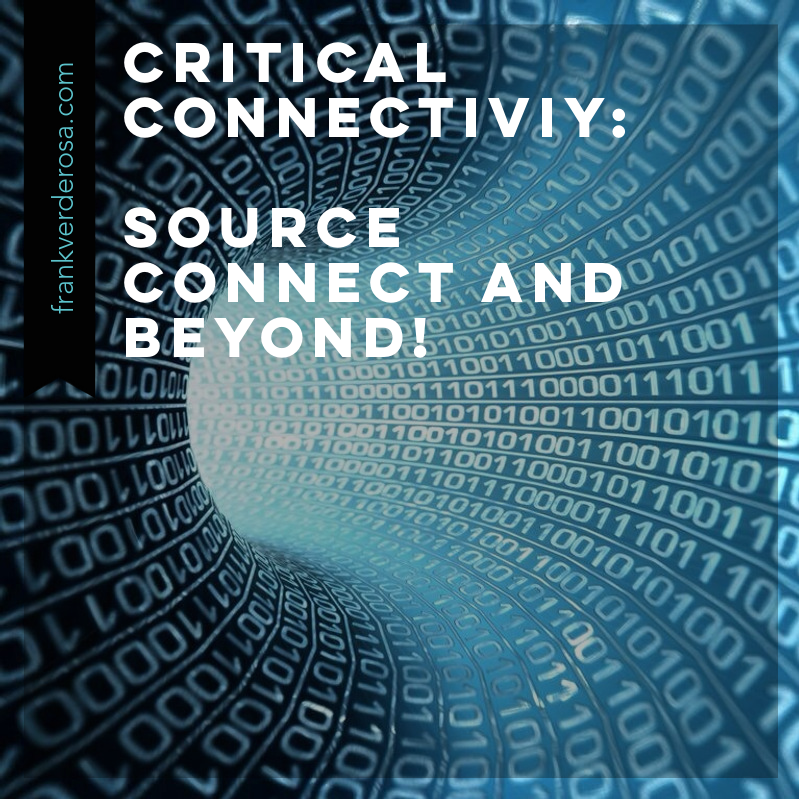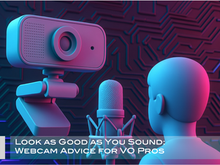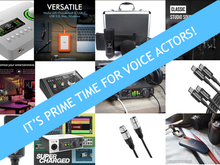Top 5 Source Connect Session Myths Debunked
- Frank Verderosa
- Dec 3, 2023
- 8 min read
Updated: Dec 4, 2023
One of my biggest hurdles as an audio engineer is connecting to talent who are consistently exposed to bad advice and/or misinformation on social media with regards to remote session work- particularly with Source Connect. What's also problematic is that while engineers at studios (and at home) are using Source Connect practically every day (often several times a day), many voice actors use it sporadically with enough time in between sessions to forget some of the basics.
I want to take a moment to counter some of the most common comments and misconceptions I hear from voice actors when I work with them in session or consulting. If you're not sure about remote session work and want to learn best practices, what's used, and why- I would encourage you to signup for my upcoming class Critical Connectivity: Source Connect and Beyond.
Here, in no particular order, are my responses to comments. For clarification, a lot of the work I handle is commercial TV and radio- so that is the lens I am filtering through.
"You don't need Source Connect- there are lots of other options".
It's true! There are lots of ways to connect over the internett from home. However, nearly every profressinal studio around the world migrated from ISDN to Source Connect over time, and that is why your agent is telling you to get it. Source Connect Standard and above include the Source Link plugin, which allows us to record you into Pro Tools or other DAWs directly. Source Connect is a direct connection that also includes back-end support for engineers and delivers the highest quality of any of the other alternatives (although in practice, the average person would be hard pressed to tell the difference). Chrome based variants like Cleanfeed, IPDtl and so many others, all rely on technology that was handed to them by Google (which is why you need a Chrome-based browser for them to work). They'll put their own interface and features into it- but you are at the mercy of the internet on the whole. By contrast, Source Connect (for now) requires port forwarding/ port mapping for a seamless connection. When Source Connect Pro users connect to you, they may use Q Restore and Replace which, for lack of a better term, is a safety net of your files that allow us to retrieve data after a session if there were any issues. More on that later!
Source Elements' answer to all the web-based imitators was to release Source Connect Now, a totally free version that is essentially identical in pratice to all of the others. For engineers to use it, they need to have something like Nexus installed to bring that web audio into their DAW. While at the studio we have licenses for Pro and Pro X, I only use Standard at home. This doesn't allow me to use Q Restore and Replace- AND I can only record one person at a time on Source Connect. My solution for this has been to use Source Connect Now in mutliple browsers and Source Nexus to bring them all into Pro Tools. So if a radio commercial has two actors and a VO at the end, I can record all three of them together using two instances of Source Connect Now alongside Source Connect Standard! This brings remote sessions more in-line with in-person sessions before covid, and saves the clients a TON of time.
Commercial work is fast paced, and there isn't always time to hold for Q Restore and Replace. As an engineer, I know that pausing for any reason breaks the session momentum, and I'll always opt for a quick pickup instead- or I might ask for a playback if possible!
Another issue with the web-based options is drift. I've recorded podcast episodes that run an hour or two, and will use a web-based option to connect while the guest rolls a backup on their end. After the recording, I'll use what I recorded as a guide fto align the guest's file. While we can't necessarily hear it, there is significant drift happening, somewtimes swinging upwards of a full second over time! So while web-based options might be fine for 30 second commercials or loop groups (Cleanfeed is really popular for those jobs), bigger projects like ADR or long-form narration will suffer from the lag.
In short, you very likely need Source Connect for higher-end jobs. Most studios are adapting and make use of other platforms, offering alternatives and a "path of least resistance" to get to the actors we want. And of course, you can always just go to the studio if that's an option!
"You need Ultra-fast Internet to use Source Connect"
This actually couldn't be further from the truth! In fact, for Source Connect to work, you need 1/3 of 1 Meg of data! Think about how small that is relative to most home internet plans, which are thousands of times greater than that! But there's a catch...
Your internet connection needs to be rock solid, and the way you achieve that is via an ethernet connection. Having more bandwidth and speed certainly helps overall, epecially when you're simultaneously connecting to Zoom or other apps. Since most current laptops don't offer an ethernet connection, you'll likely need an adaptor like this one. A simple and affordable USB-C to Ethernet adaptor certainly works, but if your MacBook only has two ports, and one is for power and the other is for your interface- you'll definitely need a more robust breakout box that will give you ethernet as well as additional USB ports.
So no- you don't need insanely fast internet just to use Source Connect. You just need a really solid and relaible connection.
"My internet is fine- so I just use wifi"
I can sum this up with a true story from early in lockdown. I had hosted an event on Source Connect and had Robert
Marshall from Source Elements as a guest so actors could hear "straight from the horses mouth" how and why things work. An actor friend asked about wifi, because that's what they'd been using. Robert made the point that wifi works- until it doesn't. There are too many external factors that effect a wifi signal, and dropouts on Source Connect are not subtle. He then proceeded to explain a lot of what I've already discussed here.
The very next day, that same actor emailed to say "I had a Source Connect session with a studio in Chicago, and wouldn't you know it- my wifi signal was having issues and I was getting dropouts! And the engineer on the other end kept telling me what to do". I asked what studio it was (since I often connect to Chicago studios). They said "It was a studio called Sum1". I followed up with "Was the engineer named Robert?". They said "Yes!", to which I replied "That's Robert Marshall- the very guy you spoke to last night who explained why Wifi isn't always reliable!!". What are the odds?
If you're wifi is being shared with others in your house that are gaming, streaming video, or on a Zoom call for work, your bandwidth is likely compromised. Ethernet solves this issue easily and definitively. In my class, we discuss all of the various ways you can move ethernet across long distances in your home. For further reading, check out my previous post Why Ethernet Matters in a Wifi World.
"I don't need to play takes back- that's the engineers job!"
This is a tough one, because it's a mixed bag on understanding how session workflows go. Yes- on a Source Connect session, the actor is sending signal for the engineer to record, edit and playback for clients. And in theory, you should never have to worry about playing back anything. But sometimes issues arise. If the engineer on the far end is using Source Connect Pro or Pro X, they might be running Q Restore and Replace. This allows them to retrieve files or even the whole session after the fact as long as you're both setup correctly for it. It's a brilliant aspect to Source Connect, but one that I hardly ever use. I've found that it's quicker to just say "We had a dropout- can you just give me three in a row on that line?" than it is to pause to fix it with restore and replace. I also find in practice that it's hard enough to get actors to understand getting Source Connect up and running without introducing them to Q Manager for this to all work. I teach it in my class, but as I said- I personally have never once used it, and generally speaking, neither have any of the other large commercial studios I connect to on a daily basis. Obviously if they request it, we make sure Q manager is up and running.

So besides a dropout, why else might you want to play back? Well- there are often moments in sessions where you might be rehearsing a bit of client feedback before a take and you NAIL it! Since you're rolling a backup on your end (you are rolling, right??), when the client inevitably says "That was perfect- did we get that?"- even if the engineer wasn't rolling, you can say "I got it if you want me to play it back". You are now a hero! I learned early in my career to always roll those rehearsals, because you never know. I'll even be sneaky and tell you to run it a few times before we roll- but roll anway. Most actors know my tricks, but humor me anyway.
Commercial work is fast paced, and there isn't always time to hold for Q Restore and Replace. As an engineer, I know that pausing for any reason breaks the session momentum, and I'll always opt for a quick pickup instead- or I might ask for a playback if possible!
"I have Source Connect- but the FREE version"
I hate to be the barer of bad news, but you don't have Source Connect. As we discussed earlier, Source Connect Now is their free web browser based version, where the engineer on the recording side just sends you a link- much the same as Cleanfeed and IPDTL work. The difference is that Source Connect Now is free for all parties involved.

Personally, once I got Source Nexus as a way to route other options directly into my Pro Tools sessions- and once actors switched to ethernet instead of Wifi, Source Connect Now became a reliable tool for me! While it's primarily designed as a client participation system, the quality is good enough for many VO sessions. It's certainly a solid backup for when actors are having issues with Source Connect Standard, and has taken the pressure of the Source Connect "mandate" for me.
The bottom line...
As we settle in on the new normal for sessions in a post-Covid production chain, things continue to evolve. When lockdown started, the ask from most studios was Source Connect or nothing. And while it's still the undeniable leader in remote sessions, new options and advancements in existing platforms seem to pop-up monthly. My Source Connect and Connectivity class has evolved and adapted to these trends. To me, a lot of this tech is made to look needlessly complicated. If you're confused or need help, this class will cover using Source Connect Standard in standalone mode, through your supported DAW, in tandem with Zoom and what's involved with interfacing with most alternatives. If you need it, you can sign up up. I hope this has all helped! I promise it will take the mystery out it all.






























Comments